Toys in the Past: A History Timeline
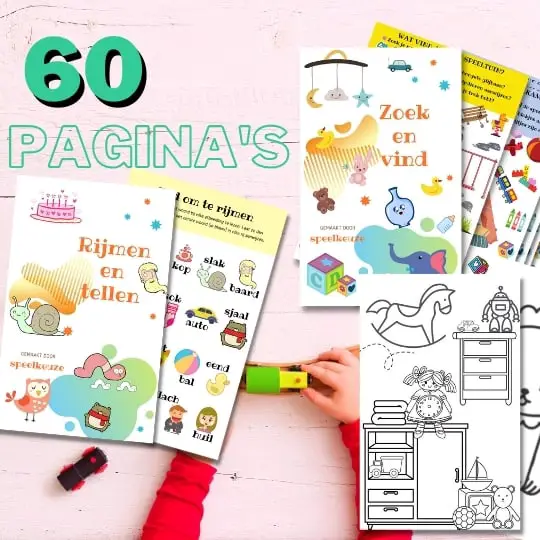
Always something to do for the holidays or rainy day?
Play Choice now has the ultimate activity book collection, with over 60 pages of fun coloring pages and educational puzzles.
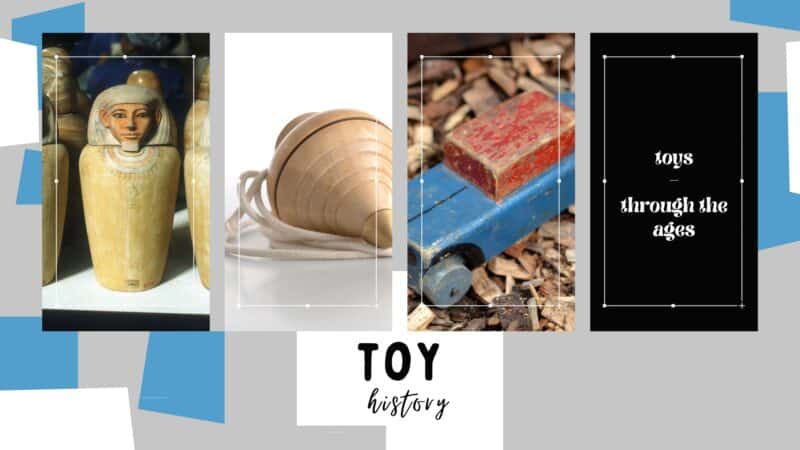
The origin of the word toy is unknown, but probably dates back to the 14th century. There were toys before that, but they were usually self-made. Ancient toys found in the remains of ancient cities show that games have been a part of human history for thousands of years.
Animals, for example, were often used as models for these early toys and were made from simple materials such as wood, clay or glass. Examples include spinning tops, dolls and marbles.
With the invention of plastic in the 20th century, toys became cheaper and accessible to more people. Plastic toys, in all shapes and sizes, dominate the market today. These toys are often colorful and stimulate children's creativity and imagination.
Despite the evolution of toys over the years, the essence remains the same: having fun and learning through play.
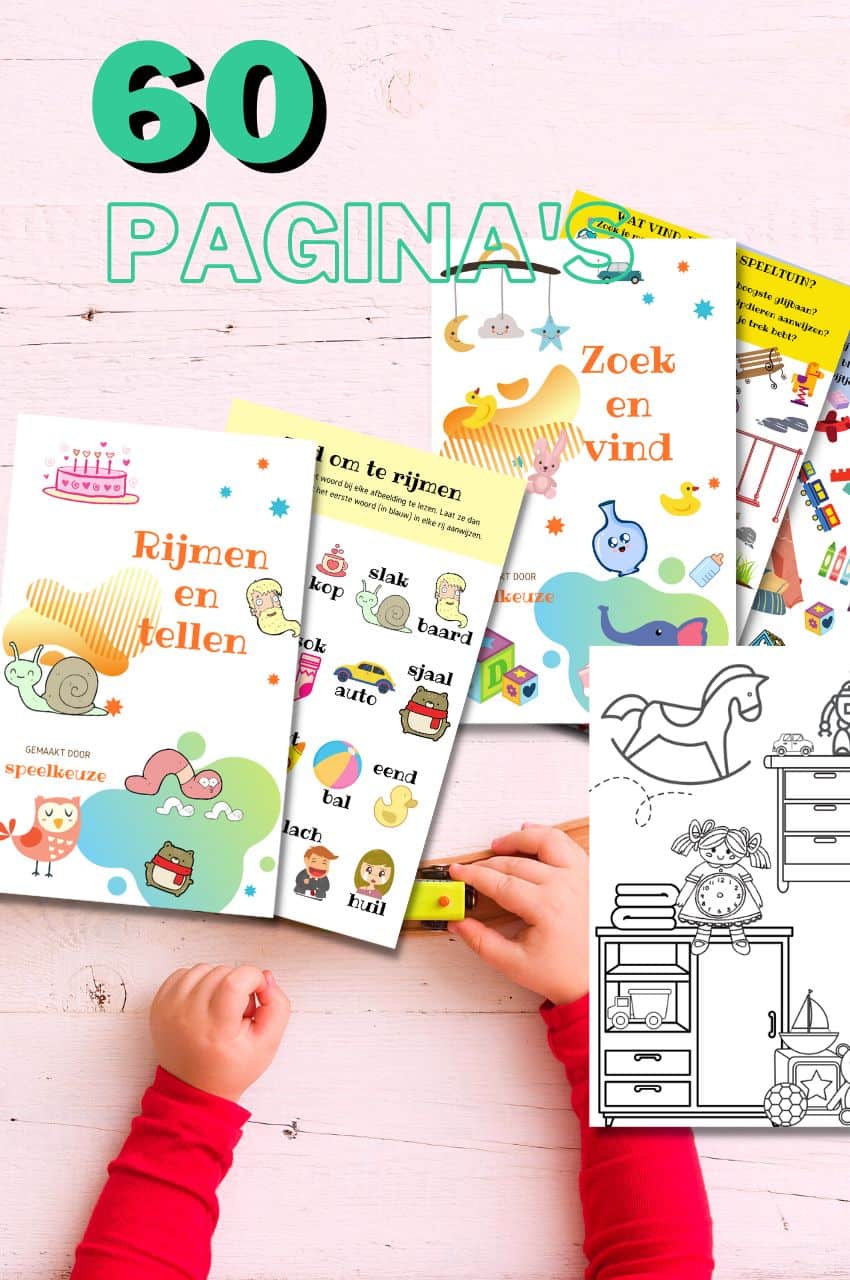
From toddler to toddler activity book collection
Educational games and coloring pages for 3 to 6 years
Your toddler and preschooler will love this e-book, along with the accompanying printables. He or she can play with it at every stage of development, together with mom and dad.
Buy at Bol.comWhat we discuss in this comprehensive post:
How have toys evolved over the years?
Toys have evolved over the years from the earliest playthings as natural objects, possibly used to imitate adult activities, such as weapons, as an aid in survival into adulthood, to elaborate intellectual products aimed at learning specific skills for a later job.
Below is a comprehensive timeline of toy development.
- Invention: The oldest toys and games were simple and made of natural materials.
- Toys and games from ancient times: Rich children played with durable but simple toys, such as wooden spinning tops and dolls.
- Toys from the 16th century: Marbles, also made as 'knucklebones' for a slightly different game, were small toys made from sheep or goat bones. Dolls, sometimes called 'Bartholomew babies' because they were sold at the St. Bartholomew's Fair in England, also became more popular.
- Toys from the 17th century: Making toys was a time-consuming hobby. Wooden toys were often carved and painted by hand. Clay was shaped and baked to make durable toys. Fabric dolls were sewn and stuffed by hand.
- Toys from the 18th century: Toys from the 18th century were diverse, but still largely the same as previous centuries and made from natural materials such as wood. Examples include marbles, soldiers, horses and dolls.
- Toys of the Victorian Era (1900): Toys were diverse and reflected the social changes of the time. They were often handmade, with materials such as wood, metal and fabric. Various toys, such as dolls, toy cars and teddy bears were popular, although the literal “teddy bear” was not invented in America until 1902.
- Toys of the 20th Century: Plastic became a popular material for toys, making them cheaper and available to the masses.
- Toys of the 21st Century: Electronic and video game toys became increasingly popular, alongside technological developments such as autonomous toy robots.
The evolution of toys reflects human development, with toys serving to instruct children and stimulate their imagination. Below you see an image of the history of toys in a timeline.
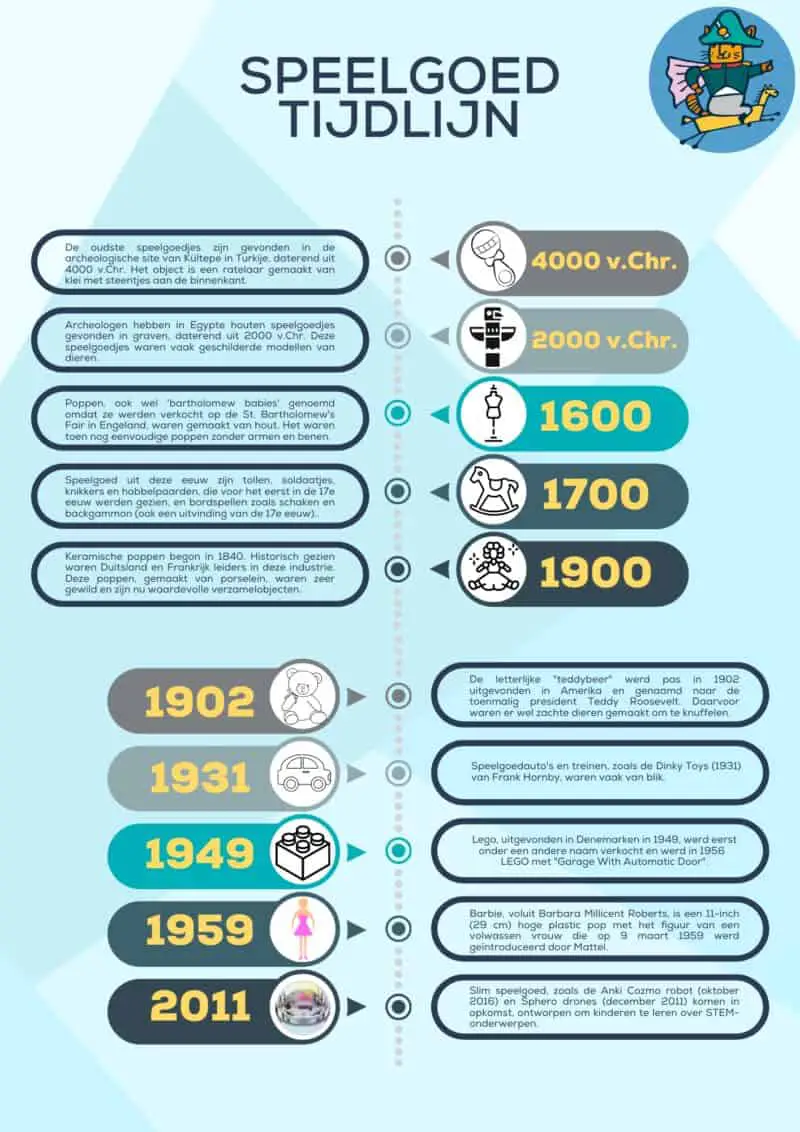
1. Invention of toys
Toys were not invented so much as they have probably always been part of people's existence, from a stick as a club or sword to a clay figure and some twigs. The oldest manufactured toys are from 4000 and 3000 BC, based on archaeological finds.
Archaeologists believe that the first toys were probably made by parents for their children. These early forms of toys were made from natural materials such as clay, wood and stone.
The oldest toys have been found in the archaeological site of Kültepe in Turkey, dating back to 4000 BC. The object is a rattle made of clay with stones on the inside. This makes a sound when you shake it, just like modern rattles.
These first toys were often simple models of animals and people, made of clay.
The invention of toys was an important step in human history. It showed that people valued play and fun from early in history. The toys evolved over time, reflecting technological advances and society's changing tastes.
2. Toys and games from ancient times
Some of the oldest toys in history are marbles, spinning tops and puppets. Marbles were popular in ancient Rome and China, dating back thousands of years. They were usually made from natural materials such as clay or stone. Manufactured toys were only for the rich.
Toys were also popular in ancient Egypt. Archaeologists have found wooden toys in graves dating back to 2000 BC. These toys were often painted models of animals.
Toys were also popular in ancient Greece. The earliest reference to toys in Greek literature dates to the 5th century BCE. These toys were often made of clay or wood.
Toys dating back to the Han Dynasty (206 BC - 220 AD) have been found in China. These toys were often made of clay or wood and represented animals or people.
Spinning tops, similar to those we know today, were also popular in ancient Rome. These spinning toys were often made of wood or bone. They served as both a distraction and a way to get children's attention.
Pull toys, often in the shape of animals or chariots, were widely used in ancient Sumer around 2000 BCE. These toys were usually made of wood and were pulled behind them by children.
In ancient Rome, dolls were a favorite toy for girls. These dolls, often made of wax, had movable limbs and were often found in the graves of wealthy Roman children.
Games were also an important part of the old toys. In ancient Rome, gambling and betting games such as goose racing and mouse-powered chariot racing were popular. Board games such as chess were also played in ancient Rome, although probably not until the later empire, which lasted until 1453. Chess was invented in India during the Gupta dynasty in the 6th century.
In ancient China, cloth swords were a common toy. These were often used in role-playing games, where children reenacted battles and wars.
Finally, in ancient Sumer, rattles were a popular toy for babies. These rattles, often made of clay, served as a distraction and attracted the baby's attention.
3. Toys from the 16th century
Toys from the 16th century were made of natural materials such as wood and metal. In those centuries, toys were comparable to those of the Middle Ages and the Renaissance. Examples of toys included marbles, stilts, dolls, spinning tops and whistles.
Marbles, also made as 'knucklebones' for a slightly different game, were small toys made from sheep or goat bones.
Dolls, also called 'Bartholomew babies' because they were sold at the St. Bartholomew's Fair in England, were made of wood. At that time they were still simple dolls without arms and legs. These wooden babies, as they were known, were not called 'dolls' until the 18th century.
Toy making involved the use of wood, metal and natural resin. Wooden toys were carved from blocks of wood, while metal toys were formed by melting and casting metal. Natural resin, or tree sap, was used as a glue.
Playing with toys often involved hitting an object, such as the game 'tipcats', which involved a stick and a small wooden object. Other games, such as 'knights', were early forms of role-playing games. These games were similar to the games played in ancient times.
4. Toys from the 17th century
Toys from the 17th century were made of natural materials such as wood, clay and fabric. Examples include board games and dolls. They were used for play and relaxation.
Various toys from this century include spinning tops, soldiers, marbles and rocking horses, which were first seen in the 17th century. Board games such as chess and backgammon (also an invention of the 17th century) were also popular.
Making toys was a time-consuming hobby. Wooden toys were often carved and painted by hand. Clay was shaped and fired to make durable toys. Fabric dolls were sewn and stuffed by hand.
The use of toys varied. Board games were played for entertainment and strategy. Dolls and soldiers were used for imaginative play.
Toys from the 17th century were similar to toys from earlier times, but with more variety and complexity.
5. Toys from the 18th century
Toys from the 18th century were diverse, but still largely the same as previous centuries and made from natural materials such as wood. Examples include marbles, soldiers, horses and dolls. Board games such as chess and backgammon were also popular, as were card games. These games were not only entertainment but also educational, giving parents the opportunity to teach their children moral lessons.
Different toys were used in different ways. Marbles, for example, were used in games where the goal was to hit the opponent's marbles. Soldiers and horses were intended for pretend play, while dolls were mainly used by girls for role play.
The toys of the 18th century, while different from the toys of today, still influence the toys we know today. Many of the classic games and toys are still available and played by children.
4. Victorian Era Toys (1900)
Toys from the Victorian era of the 1900s were diverse and reflected the social changes of the time. They were often handmade, with materials such as wood, metal and fabric.
Various types of toys, such as dolls, toy trucks and teddy bears, were popular, although the literal “teddy bear” was not invented in America until 1902 and named after then-president Teddy Roosevelt. Before that, there were soft animals made for cuddling.
The toy wagon was invented in the 1880s, with the first versions being handcrafted and made entirely of wood.
Dolls were often made of porcelain or bisque, while teddy bears were made of cloth and stuffing.
Making toys was a labor-intensive process. They were often made by craftsmen in small workshops. The first mass-produced toys probably date back to the 1830s when commercial mass production became more popular. Still handmade of course, but with the same design instead of separate craft toys.
Production of ceramic dolls in factories began in 1840. Historically, Germany and France were leaders in this industry. These dolls, made of porcelain, were highly sought after and are now valuable collector's items. They were considered miniature adults with rosy cheeks and stiff postures, reflecting the vulnerable state of children at the time.
Around 1878, dolls made of celluloid, a plastic, were produced in Germany. Celluloid rattles and bath toys soon followed, first appearing around 1890. But it wasn't until the 20th century that plastic would be widely used for toys.
Toy soldiers have probably been around as long as real soldiers, but it wasn't until the 1890s that mass-produced toy soldiers became possible thanks to new manufacturing techniques, made by pouring liquid lead into a mold, which then solidified into a solid figure as it cooled.
The use of toys was for fun as well as educational purposes. They helped children learn skills such as hand-eye coordination and creativity.
5. Toys of the 20th century
20th century toys were diverse and reflected technological advances and societal changes. Popular sets included Barbie dolls, introduced in America on March 9, 1959, and Lego, invented in Denmark in 1949. Traditional toys such as spinning tops and marbles remained popular.
Different types of toys were made and used in different ways. Stuffed bears and dolls, such as Raggedy Ann (1915) and Betsy Wetsy (1934), were made of fabric. Toy cars and trains, such as Frank Hornby's Dinky Toys (1931), were often made of tin.
Toy cars, while not as old as dolls or teddy bears, have interesting origins. They emerged around the turn of the 20th century, when the automobile was a new and exciting phenomenon. These toy cars were often detailed replicas of real cars and were seen as luxury items.
Plasticine, introduced commercially in the 20th century, also gave poorer children the opportunity to obtain their own toys. After the Second World War, around 2, plastic toys became more popular as celluloid gave way to new forms of plastic.
The toys of the 20th century also had an educational role. Lego stimulated creativity and spatial awareness, while Monopoly taught children about economics. Toys also reflected the changing society. Barbie, for example, was seen as a symbol of feminism and changing gender roles.
The toys of the 20th century were not just for children. Collectors appreciated the detail and realistic representation of model trains and cars. These reflected the rise of car culture and advancing technological developments.
At the end of the 20th century, board games for adults were also popularized with, for example, Catan (then Settlers of Catan, 1995).
The first smart robots also entered the market, although very limited in their functions, the first being Mego Corporation's 2-XL Robot in 1978.
6. Toys of the 21th century
21st century toys are diverse and technologically advanced. Popular examples include action figures, board games and smart toys. Technology has influenced toy design, with connected toys allowing for circuitry. Companies like Google produce connected devices for 21st century children.
Different types of toys are designed for different purposes. For example, action figures are made for collection and play. Board games that adults like to play with their children such as Ticket To Ride (2004). Smart toys, such as the Anki Cozmo robot (October 2016) and Sphero drones (December 2011), are designed to teach children about STEM topics.
Toy production has also changed in the 21st century. Many toys are now made using technology such as 3D printing and automated assembly lines. This has led to an increase in production efficiency and a reduction in production costs.
The use of toys has also evolved. Children can now have interactive experiences with their toys, thanks to technologies such as virtual reality. The Oculus Quest VR headset, for example, allows children to play in virtual environments. Smart toys can also be connected to the internet, allowing children to control their toys with apps on their smartphones or tablets.
So in the 21st century, toys have changed not only in design and production, but also in how they are used. It is a reflection of the changing times and the increasing influence of technology on our daily lives.
What does the pop history timeline look like?
The oldest doll was discovered in Siberia and is 4.500 years old. In ancient Egypt, dolls were also made of wood. The oldest dolls with movable arms and removable clothing date back to 200 BC, and in Greece dolls had articulated hips and shoulders.
In the 16th century, the first dolls with fashionable clothes became popular in France, and in Germany and the Netherlands, so-called “peg” dolls were cheap and popular and were already made for a wider audience than just the very rich.
In the golden 19th century, the Victorian era, porcelain and biscuit dolls with China heads were sold.
Production of ceramic dolls in factories began in 1840. Around 1878, the first dolls made of celluloid, a plastic, were produced in Germany.
In the early 20th century, more mass-produced soft dolls came onto the market, such as Raggedy Ann (1915) and Betsy Wetsy (1934).
Barbie was introduced in America on March 9, 1959 and forever changed the way we look at dolls. Before that time, dolls were mainly in the shape of babies and children, while Barbie had the head and body of an adult woman.
The first toy ever promoted as an “action figure” was GI Joe in 1964, made by Hasbro (USA). From that moment on, dolls were also marketed as specific boys' toys.
The first Pleasant Company American Girl dolls were released on May 5, 1986. 18 inch (46 cm) dolls representing girls from eight to fourteen years old, from different time periods in history.
In August 2012, the Lottie Dolls from Arklu Ltd. were released. on the market for the first time. A doll with the correct proportions of a 9-year-old girl and for the first time a clear step back towards dolls with children's bodies for children. It was also the first doll to go into space during the 2015 Principia Mission with astronaut Tim Peake.
In 2022, Innovant Tech's Somi doll, the world's first interactive African American STEM doll, hit the market to inspire a generation of Black computer scientists.
In every century, dolls reflected the changing times and social norms of the time.
Below you can see an image of the history of dolls in a timeline.
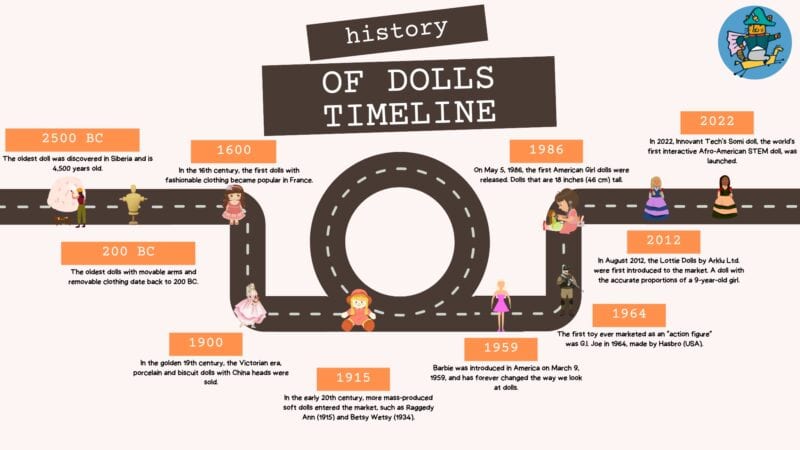
What does the history of the teddy bear timeline look like?
Stuffed animals have been around for some time, but “Teddy bears” were first created in 1902, based on an event involving Theodore “Teddy” Roosevelt, then president of the United States.
Roosevelt refused to shoot a tethered bear during a hunt. This event spread quickly through newspaper articles and was used by a political cartoonist in Washington as a metaphor for Roosevelt's indecision over the Mississippi border.
The cartoon inspired the owners of a Brooklyn candy store, the Michtoms, to create a small stuffed bear. They asked Roosevelt for permission to name the bear after him. Roosevelt agreed and so production of the “Teddy” bear began.
Almost at the same time, Richard Steiff in Germany created an articulated bear, which was later exhibited at the Leipzig Toy Fair. This bear quickly became popular and was soon exported to the United States.
Both Morris Michtom and Richard Steiff are considered the inventors of the teddy bear.
The first stuffed toy was also made by Germany's Steiff in 1880. It was an elephant made of felt, invented accidentally when families started using pincushions as toys.
They are the earliest modern stuffed toys, differing markedly from earlier rag dolls in that they are made of plush, and represent animals rather than people.
The earliest known rag doll was discovered in Egypt and dates back to the 1st century AD. This was made from scraps of fabric and papyrus.
Some of the most famous bears came in the 1920s with Rupert Bear (1920) and the most famous bear of all time, Winnie-the-Pooh (1926).
The first talking teddy bear was Teddy Ruxpin from 1985, a plush toy with a cassette tape that could tell stories while its mouth and eyes moved.
Below you see an image of the history of the teddy bear in a timeline.
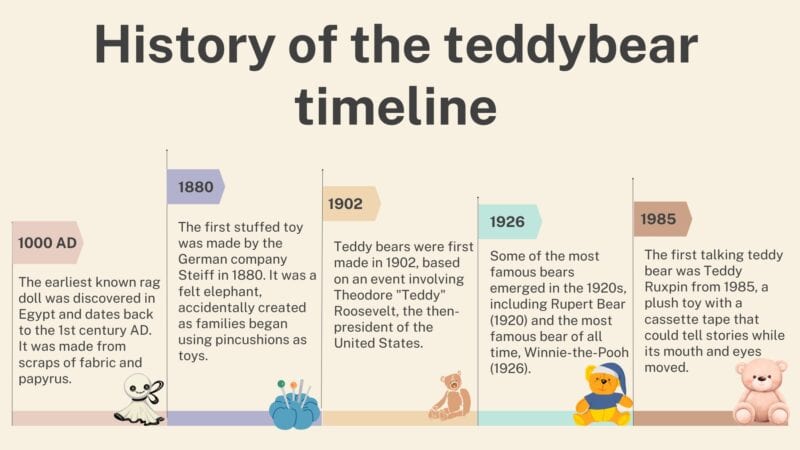
Who are the most famous toy historians?
The most famous toy historians are the following.
- Chris Bensch: Chris Bensch serves as Vice President for Collections at the Strong National Museum of Play in Rochester, New York. He oversees the museum's extensive collection of toys and is responsible for the National Toy Hall of Fame.
- Jim Silver: Jim Silver is the editor of TimetoPlayMag.com and is known as an expert on toys. He has been featured in numerous media outlets and has contributed to research into the history of toys.
- Richard Gottlieb: Richard Gottlieb is the CEO of Global Toy Experts, a toy industry consultancy. He has been active in the toy industry for more than 40 years and has contributed to research into the history of toys.
- Susan Marks: Susan Marks is a toy historian and author of the book “Finding Betty Crocker: The Secret Life of America's First Lady of Food.” She has also written about the history of toys and their influence on American culture.
- Tim Walsh: Tim Walsh is a toy inventor and author of the book “Timeless Toys: Classic Toys and the Playmakers Who Created Them.” He has contributed to research into the history of toys and their impact on society.
What are fun facts about toys and buying toys?
Below you will find some fun facts about toys.
- Toys have been around since prehistoric times. Archaeologists have discovered toys used by ancient civilizations.
- The first toy advertisements on television were for Mr. Potato Head. This toy was introduced in 1952.
- The game Candyland was invented for children who suffered from polio and were bedridden.
- The Rubik's Cube was invented by Hungarian sculptor and architecture professor Ernő Rubik.
- Star Wars figurines were a huge hit with children and collectors alike.
- The Cabbage Patch Kids toy phenomenon was introduced in the 80s.
- Minecraft, a popular toy based on the digital world, was born from the experience of playing with LEGO.
- In Victorian times, toy wagons and animals were often used to teach children to care and care.
- Toys have an important cultural and historical significance and this has always been important for developing and choosing toys. The toys that children play often reflect the roles and duties of adults in their culture.
- Cast iron piggy banks were popular toys in the 19th century. They were often used to teach children the importance of saving.
When did technology come into toys?
Technology first came into toys in the early industrial era. Handmade toy models were replaced by mass produced items. Color lithography, a technological advance from the nineteenth century, made it possible to make toys more attractive.
Electric toys also became popular, with moving model trains, race tracks and airplanes. Technology also made it possible to create toy cars and dolls that could move in a realistic way.
The development of microcomputers made programming of robot toys possible, offering children a new way to interact with technology.
Modern technological innovations have further influenced the way toys are made and used. For example, the development of virtual reality has led to new types of toys and play experiences.
Toy industries have also benefited from technological advances, allowing them to produce more complex and sophisticated toys. STEM toys, which use technology to teach children about science, technology, engineering and math, are an example of how technology has changed the toy landscape.

Always something to do for the holidays or rainy day?
Play Choice now has the ultimate activity book collection, with over 60 pages of fun coloring pages and educational puzzles.
Joost Nusselder, the founder of Speelkeuze.nl is a content marketer, father and loves trying out new toys. As a child he came into contact with everything related to games when his mother started the Tinnen Soldaat in Ede. Now he and his team create helpful blog articles to help loyal readers with fun play ideas.
